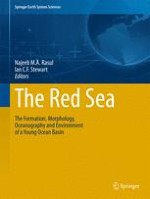2015 | OriginalPaper | Chapter
Impacts of Climate Change on the Red Sea Region and its Watersheds, Saudi Arabia
Authors : Mohamed Sultan, Saleh Sefry, Mazen AbuAbdallah
Published in: The Red Sea
Publisher: Springer Berlin Heidelberg
Activate our intelligent search to find suitable subject content or patents.
Select sections of text to find matching patents with Artificial Intelligence. powered by
Select sections of text to find additional relevant content using AI-assisted search. powered by
